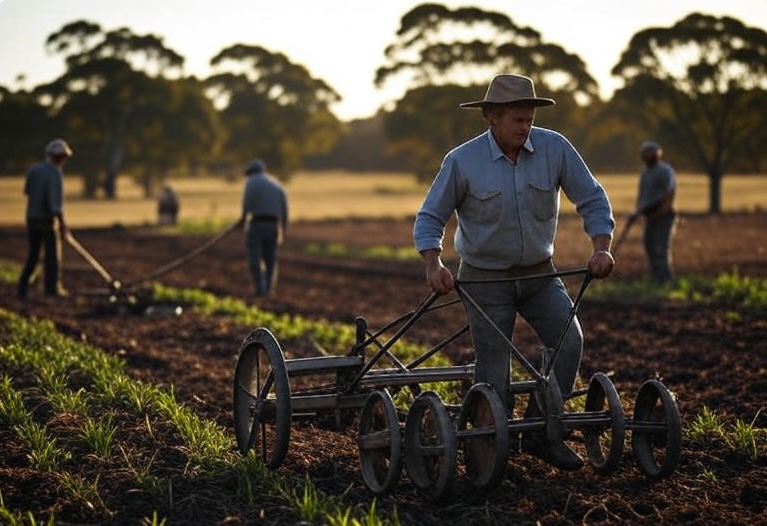Soil Carbon Sequestration Techniques for Climate Mitigation in Australia
In an era where climate change looms large, innovative solutions are blazing trails toward a sustainable future. One such promising avenue is soil carbon sequestration—a natural process that could help lock away billions of tonnes of CO2 from the atmosphere. In Australia, with its vast agricultural lands, diverse climates, and unique environmental challenges like droughts and bushfires, this approach holds particular promise. But what exactly is it, and how can we harness it effectively? In this post, we'll dive deeper into the techniques, benefits, challenges, and the latest insights on using soil as a powerful ally in mitigating climate change, with a focus on Australian contexts. We'll also explore how everyday Australians can apply these principles in their own backyards.
What is Soil Carbon Sequestration?
Soil carbon sequestration, or SOC, refers to the process of capturing atmospheric CO2 and storing it in the soil as organic carbon. This happens primarily through plants via photosynthesis, where they convert CO2 into organic compounds that eventually make their way into the soil through roots, residues, and microbial activity. Australia's soils hold immense potential for carbon storage, given the country's extensive farmlands, rangelands, and even urban green spaces. By enhancing this natural storage, we can offset a significant portion of emissions—potentially sequestering substantial amounts from agricultural lands and contributing to national targets.
In Australia, the potential is significant: soil carbon sequestration is a key priority in the government's Long-Term Emissions Reduction Plan, aiming for net zero by 2050. Estimates suggest that improved management could sequester carbon across vast areas, with projects earning Australian Carbon Credit Units (ACCUs) under the Emissions Reduction Fund (ERF). However, challenges like a warming climate could turn Australian soils into net emitters of CO2, underscoring the urgency of action. Recent advancements, including AI-driven monitoring and region-specific research, are helping to refine these estimates and maximise effectiveness.
Key Techniques for Enhancing Soil Carbon
To realise this potential, Australian farmers and land managers can adopt a range of techniques tailored to local soils, climates, and farming systems. These practices focus on increasing carbon inputs, reducing losses, and improving soil health. Here's a more detailed breakdown of some of the most effective ones, with Australian examples and considerations:
- Conservation Tillage (No-Till or Reduced Tillage): This minimises soil disturbance, preventing the release of stored carbon while allowing crop residues to decompose naturally on the surface. In Western Australia, wheat farmers have seen up to 20% increases in soil carbon levels after adopting no-till practices, which also help combat wind erosion in dryland areas. It can sequester 0.1 to 1.3 tonnes of carbon per hectare per year and is particularly effective in reducing erosion in arid regions like the Mallee.
- Cover Cropping: Planting cover crops like legumes (e.g., clover or beans) during off-seasons adds year-round carbon inputs through roots and residues. When ploughed under as green manure, they boost SOC levels and enhance biodiversity, as seen in carbon farming plans across Australian croplands. In Queensland, subtropical cover crops like lablab are used to maintain soil cover during wet seasons.
- Crop Rotation and Diversification: Alternating crops introduces varied residues, improving soil structure and nutrient cycling. This technique helps maintain or increase SOC by promoting a diverse microbial community, suitable for mixed farming systems in Australia. For instance, rotating cereals with pulses in South Australia reduces disease pressure while building carbon.
- Organic Amendments (Compost, Manure, and Biochar): Applying compost, manure, or biochar directly enriches the soil with stable carbon forms. Biochar, in particular, offers long-term sequestration and can improve yields by enhancing nitrogen efficiency, with applications in nutrient-poor Australian soils like those in the Northern Territory.
- Agroforestry and Afforestation: Integrating trees into agricultural systems or restoring forests on degraded lands increases carbon inputs through deeper roots and litter. This is especially useful for mineral soils, which dominate Australian landscapes, and can provide shade and windbreaks in regions prone to extreme heat.
- Pasture and Grazing Management: Controlled grazing, fertiliser application, and sowing adapted species on grasslands can sequester up to 0.54 tonnes of carbon per hectare per year on average, turning vast rangelands into carbon sinks. In NSW, considerable potential exists in higher rainfall pasture lands (>450 mm), where rotational grazing prevents overgrazing.
- Restoring Degraded Soils and Wetlands: Rewetting drained peatlands reduces carbon losses, while restoration programs can build SOC at rates of 0.6–1 tonne per hectare per year. In Victoria, wetland restoration projects are linking carbon benefits with biodiversity gains.
- Microbiome Interventions: Emerging approaches involve manipulating soil microbes to enhance carbon storage, potentially curbing greenhouse gas emissions from managed Australian soils. Research from CSIRO is exploring microbial inoculants tailored to local conditions.
For scaling in Australia, these practices need region-specific adaptations, such as addressing yield gaps in drier areas or synchronising nutrient management to avoid trade-offs like increased N2O emissions.
| Technique | Potential Sequestration Rate (tonnes C/ha/year) | Best Suited For in Australia |
|---|---|---|
| Conservation Tillage | 0.1–1.3 | Croplands with high erosion risk, e.g., WA wheat belts |
| Cover Cropping | Variable (enhances inputs) | Seasonal farmlands in NSW and VIC |
| Organic Amendments | 0.2–0.5 (for manure/compost) | Nutrient-poor soils in arid zones |
| Agroforestry | 0.5–2.0 | Mixed farming systems in QLD |
| Pasture Management | 0.11–3.04 (mean 0.54) | Grasslands and rangelands in higher rainfall areas |
| Degraded Soil Restoration | 0.6–1.0 | Eroded or abandoned lands across the continent |
Suggestions for the Home Gardener
While large-scale farming drives much of the SOC conversation, home gardeners across Australia can play a vital role in carbon sequestration right in their backyards. Urban and suburban soils, often degraded from construction or overuse, offer untapped potential for storing carbon while creating productive, resilient gardens. By adopting regenerative practices, you can improve soil health, reduce your carbon footprint, and even grow more food or support local wildlife. Here are some practical, Australia-focused suggestions to get started:
- Start Composting: Turn kitchen scraps, lawn clippings, and garden waste into nutrient-rich compost. Apply it annually to your garden beds to boost organic matter and microbial activity. In drier climates like Perth or Adelaide, use worm farms or enclosed bins to conserve moisture and prevent nutrient loss.
- Mulch Generously: Cover bare soil with organic mulches like straw, wood chips, or native leaf litter to retain moisture, suppress weeds, and slowly add carbon as it decomposes. This is especially useful in Australia's hot summers to combat evaporation—aim for a 5-10 cm layer around plants.
- Adopt No-Dig Gardening: Avoid tilling or digging to preserve soil structure and fungal networks. Instead, layer organic materials (cardboard, compost, mulch) to build raised beds. This method, popular in community gardens in Melbourne and Sydney, can increase SOC while reducing effort.
- Plant Cover Crops or Green Manures: In veggie patches, sow quick-growing legumes like peas or vetch between seasons, then chop and drop them as mulch. For Australian gardens, incorporate native groundcovers like kidney weed to enhance biodiversity and carbon inputs without water-intensive imports.
- Incorporate Biochar or Organic Amendments: Mix biochar (charred organic material) into soil for long-term carbon storage—it's stable for centuries. Source it locally or make small batches at home. Combine with manure or seaweed-based fertilisers to suit coastal areas like Brisbane.
- Grow Perennials and Natives: Focus on perennial plants, shrubs, and trees that develop deep roots for ongoing carbon sequestration. In your backyard, plant Australian natives like kangaroo paw or eucalypts to support local ecosystems, improve water retention, and sequester carbon with minimal inputs.
- Monitor and Adapt: Test your soil pH and carbon levels with affordable kits from garden centres. Join local groups like Landcare Australia for tips tailored to your region, and track changes over time to see your impact.
These small actions can collectively make a big difference, especially in urban areas where community gardens in places like Perth have shown higher soil carbon and water-holding capacity. Remember, consistency is key—healthy soil builds over years.
Benefits Beyond Climate Mitigation
While climate mitigation is the headline act, SOC offers a symphony of co-benefits for Australian agriculture and beyond. Increasing SOC improves soil structure, boosts water retention (a 1% increase can hold up to 75,000 litres more per hectare), and enhances fertility, leading to higher crop yields and resilience to droughts. It addresses food, water, and energy security, preserves biodiversity, and supports resilience against extreme weather events like floods in Queensland or heatwaves in the outback. In degraded areas, it can close yield gaps while reducing fertiliser needs. Overall, it's a "win-win" strategy that purifies water, restores ecosystems, and aligns with sustainable development goals, including those for urban green spaces.
Challenges and Limitations
Despite the promise, SOC isn't a silver bullet in Australia. Measuring changes is tricky due to soil variability, slow accrual rates (<1% annually), and the need for accurate verification. Carbon storage isn't permanent; it can be lost through poor management or climate events, with projections showing soils becoming net emitters under warming scenarios. Barriers include financial constraints, lack of high-resolution soil data, and policy issues like the current method's focus on short-term increases.
To overcome this, the government is investing in innovations like the $40 million National Soil Carbon Innovation Challenge for low-cost measurement tech. AI and satellite analytics are emerging tools to reduce costs and improve accuracy, with applications from farms to home gardens.
The Path Forward
Scaling up requires policies like the ERF, ACCUs, and the National Soil Action Plan 2023–2028, alongside multistakeholder collaborations with agribusinesses, NGOs, and community groups. Initiatives from CSIRO and the Department of Climate Change, Energy, the Environment and Water (DCCEEW) are paving the way, emphasising data harmonisation and success stories from local farms in NSW and WA. Linking SOC to carbon markets can accelerate adoption, including incentives for small-scale participants like home gardeners.
Conclusion
Soil carbon sequestration is more than a technique—it's a trailblazing approach to healing our planet, tailored to Australia's unique landscapes. By adopting these practices, from vast farms to humble backyards, we can mitigate climate change while building resilient ecosystems. The road ahead demands innovation, collaboration, and evidence-based action. Let's keep blazing that trail toward a cooler, greener Australia. What are your thoughts on implementing these on your land or in your garden? Share in the comments!

